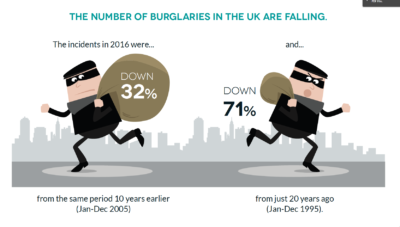
 Ironmongery Direct reports that the number of burglaries in the UK are falling. According to the latest statistics, incidents in 2015 were down 33% from the same period 10 years earlier (Jan-Dec 2005) and 70% just 20 years ago (Jan-Dec 1995).
Ironmongery Direct reports that the number of burglaries in the UK are falling. According to the latest statistics, incidents in 2015 were down 33% from the same period 10 years earlier (Jan-Dec 2005) and 70% just 20 years ago (Jan-Dec 1995).
However, according to the Office for National Statistics, there were 401,718 police-reported burglaries between January 2015 and December 2015 – giving a burglary rate at seven offences per 1,000 people.
That also means that, on average, there were 1,100 burglaries per day reported to police. That’s 45 per hour.
When taking account all burglaries (aside from police-reported) – an estimated 713,000 burglaries are said to have taken place, which means there were an estimated:
- 1,953 burglaries per day
- 81 per hour
- 1.35 each minute
In 2000, a Home Office study concluded that the average burglary costs £2,300 per incident. Adjusted for inflation, that figure is now £3,600, not counting the rise in commonly stolen electronic devices such as smartphones, which cost an average of £180 each, and laptops (average cost £692 each).
According to insurer’s MoneySuperMarket, the 10 areas with the highest rate of burglary in the UK are in our capital:
Most burgled postcodes:
- SE21 South Tulse Hill & Dulwich, South London
- IG5 Clayhall, Ilford, East London
- IG4 Redbridge, East London
- IG2 Gants Hill, Newbury Park, Aldborough Hatch, East London
- N20 Whetstone district, North London
- TW5 Heston, Cranford (north), Osterley (west), West London
- EN4 Hadley Wood, Cockfosters, East Barnet, New Barnet, North London
- N11 New Southgate district, North London
- IG6 Barkingside, Hainault (south), East London
- TW11 Teddington, West London
The data also documents the UK postcodes with the lowest number of offences, with Harbury, Derry and Bishopston highlighted as some of the UK’s ‘safest’ areas.
‘Safest’ postcodes:
- CV33 Harbury
- BT48 Derry, Cityside, Ballynagard, Coshquin, Rosemount, The Collon, Culmore
- SA3 Bishopston, Blackpill, Caswell, Clyne, Langland, Mumbles, Oystermouth, Southgate, South Gower, West Cross
- SO22 Badger Farm, Fulflood, Hursley, Littleton and Harestock, Olivers Battery, Pitt, St Cross (W), Stanmore, Weeke
- SP4 Amesbury & Durrington
- BL6 Bolton, Blackrod, Horwich, Lostock, Rivington
- OX10 Wallingford, Berinsfield, Cholsey, Dorchester
- DD10 Montrose
- NG20 Shirebrook, Market Warsop
- CA13 Cockermouth, Lorton & Buttermere
Throughout history, people have made efforts to secure their homes to prevent the theft of their belongings. This began with a number of weapons and tools before morphing into the systems we use today.
Beginning with a simple wooden bolt across two brackets, locks in ancient history progressed rapidly. In periods dating as far back as 2,000BC, Egyptians began using pin tumbler locks made of wood that used a lock and key to provide access externally. This would then be improved with metallic tumbler locks in Rome.
Deadbolts and secure locks are still one of the most important factors in protecting yourself against burglary. Around 30% of all burglaries are through an open or unlocked window or door. A home without a security system is 300% more likely to be burgled.
A report by futurologist Dr Ian Pearson suggested that we may soon see intelligent alarms that can communicate with one another, directional sound emitting alarms that disorientate intruders and even affordable robotic security guards. With the price of technology dropping and home CCTV systems now available for free through Android apps, the future of home security looks ‘bright’ according to Ironmongery Direct.



